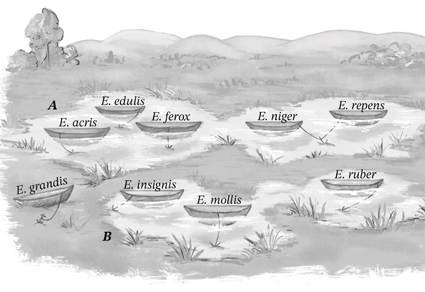Abstract
Some comments are offered on aspects of defining “taxon names”, using as a starting point the debate between Stuessy and Queiroz (plus Cantino), in 2000–2001. It is argued here that both sides in that debate were restating established positions, rather than addressing the basic question. It appears desirable to be more precise and it is important to specify context. The end-user expects a taxon name to be defined, and justly so. A taxonomic definition of a name should not be influenced by nomenclatural considerations but should be based on taxonomy only; a point worth noting is that there can be as many taxonomic definitions as there are taxonomic viewpoints. As to nomenclature, it is pointed out that, by its internal workings, a Code does not govern mere strings of characters (names), but rather formal entities.
References
- Anonymous [International Commission on Zoological Nomenclature] (1999) International code of zoological nomenclature. Fourth edition. London: The International Trust for Zoological Nomenclature. i–xxx + 1–306. <https://www.iczn.org/the-code-online>.
- Anonymous [International Commission on Zoological Nomenclature] (2003) Declaration 44. Amendment of Article 74.7.3. Bulletin of zoological Nomenclature, 60: 263.
- Anonymous [International Commission on Zoological Nomenclature] (2012) Amendment of Articles 8, 9, 10, 21 and 78 of the International Code of Zoological Nomenclature to expand and refine methods of publication. ZooKeys, 219: 1–10. <https://doi.org/10.3897/zookeys.219.3944>.
- Anonymous [International Commission on Zoological Nomenclature] (2017) Declaration 45. Addition of Recommendations to Article 73 and of the term “specimen, preserved” to the Glossary. Bulletin of zoological Nomenclature, 73: 96–97. <https://doi.org/10.21805/bzn.v73i2.a2>.
- Bremer, K., Chase, M. W. & Stevens, P. F. (ed.) [The Angiosperm Phylogeny Group] (1998) An ordinal classification for the families of flowering plants. Annals of the Missouri botanical Garden, 85: 531–553. <https://doi.org/10.2307/2992015>.
- Brickell, C. D., Alexander, C., Cubey, J. J., David, J. C., Hoffman, M. H. A., Leslie, A. C., Malécot, V. & Xiaobai Jin (ed.) (2016) International code of nomenclature for cultivated plants, incorporating the rules and recommendations for naming plants in cultivation. Ninth edition. Scripta Horticulturae, 18: i–xviii + 1–190. <https://www.ishs.org/sites/default/files/static/ScriptaHorticulturae_18.pdf>.
- Cronquist, A. (1981) An integrated system of classification of flowering plants. New York (Columbia University Press): i–xviii + 1–1262.
- Dubois A. (2000) Synonymies and related lists in zoology: general proposals, with examples in herpetology. Dumerilia, 4: 33–98.
- Hayek, A. von (1908) Zur Frage der “totgeborenen Namen” (noms mort-nés) in der botanischen Nomenclatur. Mitteilungen des Naturwissenschaftlichen Vereins der Universität Wien, 6: 57–65.
- Jørgensen, P. M. (2000) Names are defined but not as taxa. Taxon, 49: 779. <https://doi.org/10.2307/1223977>.
- Lidén, M. (2020) §193 and §246 of Philosophia botanica do not support that Linnaeus was a “typologist”. Taxon, 69: 213–216. <https://doi.org/10.1002/tax.12211>.
- May, T. W., Redhead, S. A., Bensch, K., Hawksworth, D. L., Lendemer, J., Lombard, L. & Turland, N. J. (2019) Chapter F of the International code of nomenclature for algae, fungi, and plants as approved by the 11th International Mycological Congress, San Juan, Puerto Rico, July 2018. IMA Fungus, 10 [21]: 1–14. <https://doi.org/10.1186/s43008-019-0019-1>.
- Oren, A., Arahal, D. R., Göker, M., Moore, E. R. B., Rossello-Mora, R. & Sutcliffe, I. C. (ed.) (2023) International code of nomenclature of prokaryotes. Prokaryotic code (2022 revision). International Journal of systematic and evolutionary Microbiology, 73 [5a]: 1–88. <https://doi.org/10.1099/ijsem.0.005585>.
- Pavlinov, I. Y. (2022) Taxonomic nomenclature. What’s in a name – theory and history. Boca Raton (CRC Press): i–x + 1–266. <https://doi.org/10.1201/9781003182535>.
- Queiroz, K. de (1997) The Linnaean hierarchy and the evolutionization of taxonomy, with emphasis on the problem of nomenclature. Aliso, 15: 125–144. <https://doi.org/10.5642/aliso.19961502.07>.
- Queiroz, K. de (2000) The definition of taxon names: a reply to Stuessy. Taxon, 49: 533–536. <https://doi.org/10.2307/1224349>.
- Queiroz, K. de & Cantino, P. D. (2001) Taxon names, not taxa, are defined. Taxon, 50: 821–826. <https://doi.org/10.2307/1223709>.
- Ramsbottom, J. (1942) Discussion on mycological nomenclature, 21 February 1942. Conclusions and prospects. Transactions of the British mycological Society, 25: 436–439. <https://doi.org/10.1016/S0007-1536(42)80008-X>.
- Rijckevorsel, P. van (2021) On presenting nomenclatural status. Taxon, 70: 644–647. <https://doi.org/10.1002/tax.12460>.
- Smith, G. F. & Figueiredo, E. (2021) Proposal to add a new Article 61.6 to permanently and retroactively eliminate epithets with the root caf[e]r- or caff[e]r- from the nomenclature of algae, fungi and plants. Taxon, 70: 1395–1396. <https://doi.org/10.1002/tax.12622>.
- Stuessy, T. F. (2000) Taxon names are not defined. Taxon, 49: 231–233. <https://doi.org/10.2307/1223837>.
- Stuessy, T. F. (2001) Taxon names are still not defined. Taxon, 50: 185–186. <https://doi.org/10.2307/1224520>.
- Turland, N. J., Wiersema, J. H., Barrie, F. R., Greuter, W., Hawksworth, D. L., Herendeen, P. S., Knapp, S., Kusber, W.-H., Li, D.-Z., Marhold, K., May, T. W., McNeill, J., Monro, A. M., Prado, J., Price, M. J. & Smith, G. F. (ed.) 2018. International Code of Nomenclature for algae, fungi, and plants (Shenzhen code) adopted by the Nineteenth International Botanical Congress Shenzhen, China, July 2017. Regnum Vegetabile, 159: i–xxxviii + 1–254. <https://doi.org/10.12705/Code.2018>.
- Wiersema, J. H., Turland, N. J., Barrie, F. R., Greuter, W., Hawksworth, D. L., Herendeen, P. S., Knapp, S., Kusber, W.-H., Li, D.-Z., Marhold, K., May, T. W., McNeill, J., Monro, A. M., Prado, J., Price, M. J. & Smith, G. F. (ed.) (2018–) International code of nomenclature for algae, fungi, and plants (Shenzhen code) adopted by the Nineteenth International Botanical Congress Shenzhen, China, July 2017: Appendices I–VII. <https://naturalhistory2.si.edu/botany/codes-proposals/>. [Accessed 9 March 2024].


